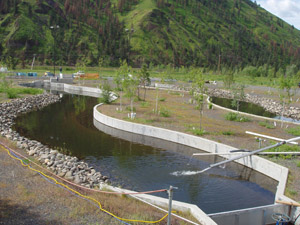Hatcheries were first established more than 100 years ago to augment wild stocks for harvest. With the ESA listing of 13 stocks of Columbia Basin fish in more recent years, however, interest and concern have grown about the effects of hatchery fish on stocks of wild fish. Read more in this BPA backgrounder.
The federal strategy is to ensure that these mitigation hatchery programs are aiding conservation and not impeding the long-term goal to recover listed salmon and steelhead.
See map of anadromous fish hatcheries in the Columbia River Basin.
Many hatchery programs have been revamped in recent years to help reduce the genetic and ecological effects on wild fish. Use of native stocks for broodstock, rearing practices that help raise stronger hatchery stocks, and avoiding mixing hatchery and wild stocks on the spawning grounds are examples of some of the reforms.
In 2006, Congress helped to convene a Columbia Basin Hatchery Scientific Review Group (HSRG) to conduct a comprehensive review and analysis of all Columbia River Basin hatchery programs. Many of the HSRG’s recommendations, completed in 2009, are being used to design and carry out best management practices in hatcheries throughout the region.

q The four tribes in the Columbia River Intertribal Fish Commission are putting fish back in the rivers using new propagation strategies to reestablish wild salmon runs. Rather than relying on conventional hatchery rearing and release methods, the tribes are using supplementation and other techniques to return salmon to their natural habitat. Read about the restoration successes here.
S-shaped raceways, with rocks and vegetation, mimic the streams and rivers where young salmon grow in the wild. Photo taken at Nez Perce Tribal Hatchery, Clearwater, Idaho.